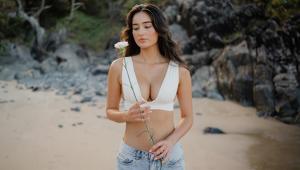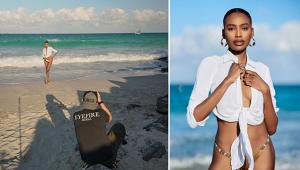Animal Lover: How Photographer Alex Cearns Creates Pet Portraits with Personality

Judging from the portraits, the pets seem to genuinely like her. She likes them, that's for sure, and maybe they sense that.
There is also the novelty factor: she's something new for them. And the fact that they don't spend too much time in her studio—the average shoot runs about 15 minutes—means that the whole thing is wrapped about the time the novelty of a new person with treats and toys wears off.
She is Alex Cearns, a multi-award-winning photographer twice named Best Canine Photographer in Australia. She is the author/illustrator of five books and is well known for her work on behalf of animal charities and rescue centers.

Cearns is also a savvy businessperson, client-driven and finely focused on communication. "Most of the owners haven't been through a photo session experience before," she says, "so I let them know what I'm going to do and where I need them to be." Which is standing next to the pets. "They're physical moral support, particularly with dogs. If the owner walks to the back of the room the dog is likely to follow them, so I keep them fairly close." At that point she generally shuts down communication between owners and pets to keep the pets' attention on her.
In the Studio
The setup is all about efficiency and results: a black (sometimes white) background, a single Profoto strobe and her familiar, reliable camera and lens combo: a Canon EOS -1D X Mark II fitted with a Tamron 24-70mm lens (SP 24-70mm F/2.8 Di VC USD G2). The camera settings are almost always the same: 1/200 second at f/13 and ISO 100. Everything in the studio, including the time-tested treats and props that keep the pets' focus on her, is designed to allow Cearns one hundred percent focus on them.
Dogs and cats sit on a foot-high ottoman. "It's like a soft couch," Cearns says, "and I'm sitting about a foot from them, on the floor, cross-legged, and they're slightly raised up on the couch. I can move quickly and zoom in or out as I need to."

She found early on that sitting really close to the animals worked best because that was where she could connect with them. "I get a lot of engagement by doing that. I can only really photograph them if I genuinely like them and they become my little furry friends."
Getting her subject's attention varies with the pet. "I find that dogs are either very easy or very hard," Cearns says. "They either love it or they're like, Nope, I'm used to being carried around and I'm not going to sit on your couch and do what you want." But she doesn't get many hard ones. "I've done this so long I can kind of win them over."
Nervous dogs won't look her in the eye, but she can often get their cooperation simply by being non-threatening, and once the picture-taking begins it's the winning combination of camera in one hand and treat in the other that gets the results. "I show them food, pull it back towards me and move it around, then give the treat. They learn that if they sit up there and look at me and do a high five or move a certain way, they get the reward. They figure it out pretty quickly."
And then there are cats.

"I find cats are pretty grumpy when they arrive because they've been in the car. The couch they sit on is like an open-topped, open-fronted box, so they can't really get out, so they kind of walk around in the box and look at me."
So, while dogs are easier to engage with—"toys and tricks and you're pretty much home free"—cats will see a treat and not acknowledge Cearns at all. And depending on how old they are, they don't respond to toys. "Some are great, though," she says. "They come in and jump around. Others just sit there or just walk around the box to look for an escape, and I just shoot."

Regardless of the pet—dog, cat, bird, bat, koala—the owner is looking for...well, call it personality: the way they know this companion of theirs. What that comes down to for Cearns is getting images with the expressions that the owners know are characteristic of their pets. It can be as simple as a certain sidelong glance or a tilt of the head.

The Professional Edge
Most of Cearns's business comes from referrals. She's worked as a professional since 2009 and does a high volume: some 400 sessions a year, half of which come from referrals. "Every single one of those clients, if you exceed their expectations and deliver what you promised, is going to tell other people, and show other people what they purchased." Those clients are essentially brand advocates.
Most of her clients are interconnected in some way. "They all know each other—they're friends or relatives." Which, in a way, is a bit of added pressure. "I have to be always on my game. I can't have an off day with photography or treating all the clients with the same courtesy."

Being on her game means all the pieces have to fit. The gear has to be reliable and versatile and its use a seamless part of the process. A remote trigger commands the Profoto strobe and its output; the operation of the EOS is second nature; and for Cearns, who is a Tamron Ambassador, the workhorse 24-70mm G2 provides vital versatility. "I can shoot wide and get the whole dog in from where I'm sitting, or I can zoom in and do a headshot without even moving. From a guinea pig to a Great Dane, I can get what I need."

The reliability and performance of the gear is essential because although from time to time she does some editing of the images in post-production, Cearns expects that what comes out of the camera will be the ideal image. "I might edit my background to make sure it's true black," she says, "or I might take my silhouette out of the catchlight in a dog's eye, or I might clean up a bit of dribble, but that's it. It's the image out of the camera that makes for authentic and honest photography."

Alex Cearns's website, at houndstoothstudio.com.au, features galleries of images, information about her books. Pet people should be prepared to spend some time viewing her collection of irresistible images.
- Log in or register to post comments

















































